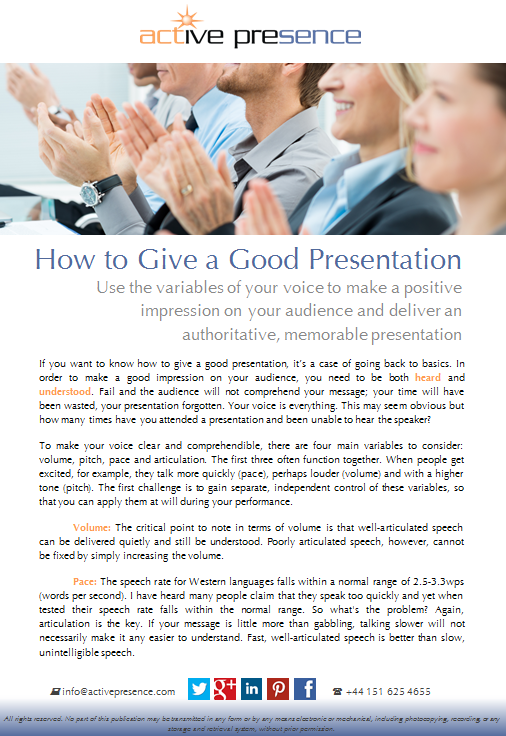How to Give a Good Presentation
Use the variables of your voice to make a positive impression on your audience and deliver an authoritative, memorable presentation
If you want to know how to give a good presentation, it’s a case of going back to basics. In order to make a good impression on your audience, you need to be both heard and understood. Fail and the audience will not comprehend your message; your time will have been wasted, your presentation forgotten. Your voice is everything. This may seem obvious but how many times have you attended a presentation and been unable to hear the speaker?
To make your voice clear and comprehendible, there are four main variables to consider: volume, pitch, pace and articulation. The first three often function together. When people get excited, for example, they talk more quickly (pace), perhaps louder (volume) and with a higher tone (pitch). The first challenge is to gain separate, independent control of these variables, so that you can apply them at will during your performance.
Volume: The critical point to note in terms of volume is that well-articulated speech can be delivered quietly and still be understood. Poorly articulated speech, however, cannot be fixed by simply increasing the volume.
Pace: The speech rate for Western languages falls within a normal range of 2.5-3.3wps (words per second). Many people claim that they speak too quickly and yet when tested their speech rate falls within the normal range. So what's the problem? Again, articulation is the key. If your message is little more than gabbling, talking slower will not necessarily make it any easier to understand. Fast, well-articulated speech is better than slow, unintelligible speech.
Pitch: In addition to changes in volume, most languages use variations in pitch and inflection to create meaning in emphasis. Variation in pitch produces interest. Generally speaking, a voice with a restricted pitch range will sound monotonous, while a voice with expensive pitch range will sound more animated and interesting. The extent and appropriateness of pitch variation helps to determine the level of interest generated.
A rise in pitch is commonly used to signal agitation or excitement, while a corresponding drop in pitch is commonly used to signal boredom or gloominess. It's useful to practice the extremes of pitch variation, so that you can call on them when required.
Articulation: Poor articulation is responsible for the vast majority of misunderstood and confused messages. Ultimately, this is due to laziness. As illustrated above, if your articulation is poor everything else is hindered beyond recovery.
Good articulation relies on synchronised movement of the lips, jaw, tongue and soft palate. As the jaw muscles are strongest in this group, they tend to dominate the production of speech. The result is that the lips, tongue and soft palate tend to get a ‘free ride’ and become lazy – resulting in poor articulation. Fortunately, this is reasonably easy to fix. Try this:
Hold the cork (from, say, a wine bottle) end-on between your teeth. Try to read a newspaper article aloud for a couple of minutes. The objective of the exercise is not to speak fast, but to speak slowly and to over-articulate all the vowels and consonants. After a short while, your mouth will probably begin to ache. Good! All those lazy muscles will be getting a decent workout. Once you have done this for a couple of minutes, remove the cork and speak normally. You will be amazed at how clear and crisp your voice now sounds
Like this page? Share it here...
The phrase "death by PowerPoint" is heard so frequently that many people believe PowerPoint to be an instrument of the devil. PowerPoint - an innocent tool brought to life by its user - is blamed for the large numbers of poor presentations delivered every day. In this post, our objective is to dispel the common myths surrounding "death by PowerPoint".

